| Friday, September 5, 2008 |
| My First Library Teen Advisory Council Visit |
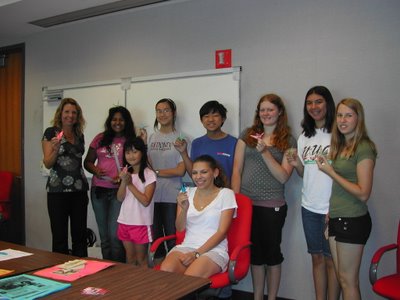
Libraries have come a long way since my childhood days. Now some teens have a voice in the development of the children/teen section of a library. On September 3, courtesy of librarian Karen Reitz, I paid a visit to the Redondo Beach Public Library's Teen Advisory Council. I was so impressed by the intelligence, commitment, and openness of their members, who range from seventh grade to twelfth. Contact your local library and see if they have a Teen Advisory Council. If not, help to start one! |
posted by Naomi Hirahara @ 9:27 AM   |
|
|
|
|
| Reunited, After All These Years |
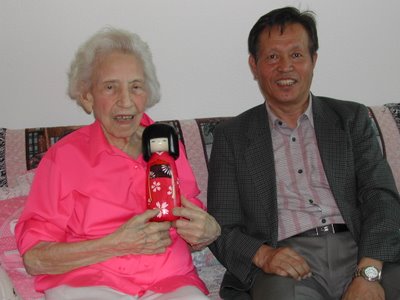
I spent a few days this past summer playing L.A. tour guide, driver, and interpreter. One of my highlights was to see Shinichi Yokoi, a Hiroshima man, meet a woman who had faithfully sent him gifts and letter while he spent his early years in an orphanage in Japan after World War II. The woman, Louise Lovinger, is 103 years old. She had saved all his childhood drawings and letters and mailed them back to him recently. They were able to finally meet face to face this summer. Oh, the kindness of strangers--never forgotten, even 50 years later. |
posted by Naomi Hirahara @ 8:28 AM   |
|
|
|
| Monday, August 18, 2008 |
| My 1001 Cranes Weekend |
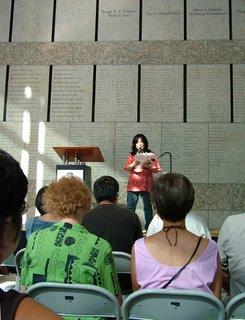 What a whirlwind of a weekend! It was the official launch of 1001 CRANES and it began at the Japanese American National Museum on Saturday, August 16. Here I'm reading an excerpt. (Photo courtesy of Diane Siegel of the Pasadena Museum of History--thank you, Diane!) What a whirlwind of a weekend! It was the official launch of 1001 CRANES and it began at the Japanese American National Museum on Saturday, August 16. Here I'm reading an excerpt. (Photo courtesy of Diane Siegel of the Pasadena Museum of History--thank you, Diane!)
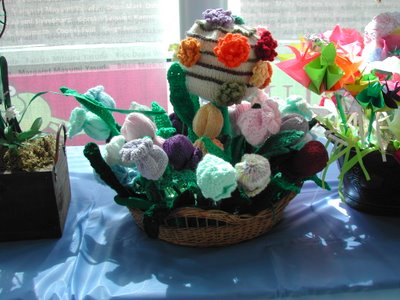 The book launch was only a small part of the museum's Summer Festival on the Courtyard. There were craft and other activities galore. The theme involved contemporary twists on tradition, in honor of the museum's current Living Flowers exhibition. The volunteers held a contest on creative flower-like arrangements. One group knitted baby socks and created a beautiful display. The socks will eventually be donated to a premie hospital unit. The book launch was only a small part of the museum's Summer Festival on the Courtyard. There were craft and other activities galore. The theme involved contemporary twists on tradition, in honor of the museum's current Living Flowers exhibition. The volunteers held a contest on creative flower-like arrangements. One group knitted baby socks and created a beautiful display. The socks will eventually be donated to a premie hospital unit.
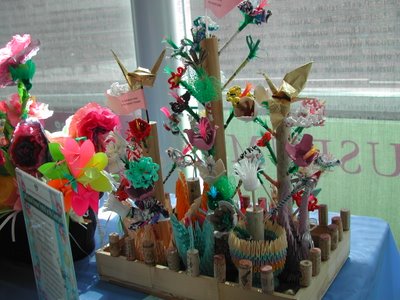 The winning entry used recycled items. The winning entry used recycled items.
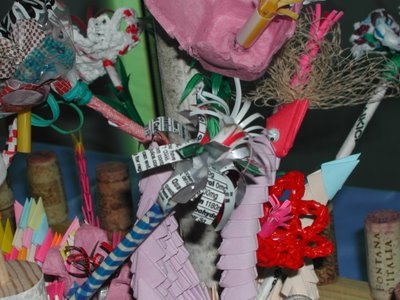 Can you see the straws, soy sauce takeout packages, cork screws, etc.? It was amazing. This is truly Japanese American art--beautiful and sensible at the same time! Can you see the straws, soy sauce takeout packages, cork screws, etc.? It was amazing. This is truly Japanese American art--beautiful and sensible at the same time!
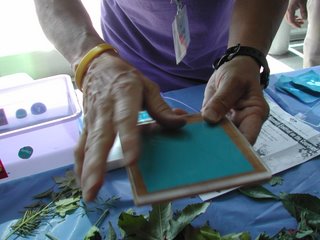 There were all sorts of craft activities. I tried my hand at making a sun print out of leaves. There were all sorts of craft activities. I tried my hand at making a sun print out of leaves.
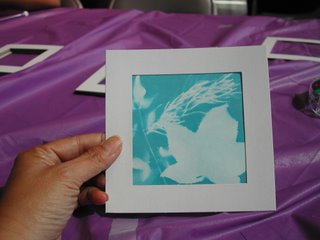 So cool, isn't it? So cool, isn't it?
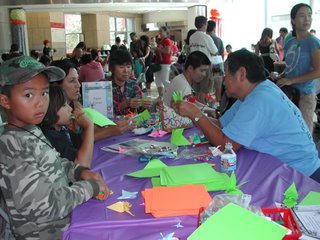 And no Japanese American craft day is complete with the folding of cranes. Here volunteer June Aoki (right) teaches youth and adults how to make a crane. June and her friends have been making origami cranes for the peace memorial for Japanese American interned during World War II organized by 14-year-old Michelle Reed and Carly Gultzmann. (See early post.) June report that the volunteers have folded 2,000 so far! And no Japanese American craft day is complete with the folding of cranes. Here volunteer June Aoki (right) teaches youth and adults how to make a crane. June and her friends have been making origami cranes for the peace memorial for Japanese American interned during World War II organized by 14-year-old Michelle Reed and Carly Gultzmann. (See early post.) June report that the volunteers have folded 2,000 so far! |
posted by Naomi Hirahara @ 11:08 AM   |
|
|
|
| Friday, August 15, 2008 |
| Friday’s Forgotten Books |
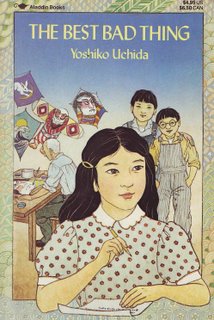
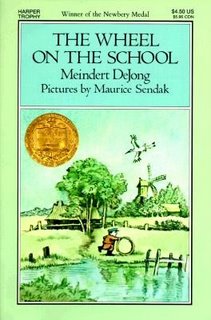 (Note: This a special series of blog posts. See the entire list of posts on Patti Abbott’s website.) (Note: This a special series of blog posts. See the entire list of posts on Patti Abbott’s website.)
Have you ever entered an old childhood haunt and been surprised how small the confines were? How a building actually was a little less majestic than you had imagined? Or perhaps how different the place is as an adult compared to your experience as a child?
I had a similar thought as I reread one of my picks for a forgotten book, THE WHEEL ON THE SCHOOL, by Meindert DeJong, a Dutch immigrant who produced a number of award-winning books in the 1950s and ‘60s. I think that as a grade student, I was working my way through Newbery Award winners when I came across THE WHEEL ON THE SCHOOL, which won the medal in 1955. I remember being captivated by the tale of children trying to attract storks back in their aging Dutch fishing village. How were they going to do it? By finding a wooden wheel they could attach to a roof for nesting purposes, of course. I loved being transported to a time of wooden shoes and simpler times.
My more recent reread of the book resulted in new discoveries. One was the pictures were drawn by Maurice Sendak (Sendak had apparently illustrated at least half a dozen of DeJong’s books). The other was that the book was dealing with themes of a rapidly aging society, man versus nature, and mobilization of a “sleeping” community. And the star of the story was a little girl, the only female out of a class of all boys. In this sense, the book was echoing very contemporary concerns, but I was surprised by the pace of the book—very slow and meandering at times. Today’s young people, I imagine, would have to adjust their expectations when tackling THE WHEEL ON THE SCHOOL.
I suppose that I related to the story and characters because as an only child for eight years, I spent a great deal of time with adults. I think also I was a more attentive reader back then. Right now I’ve been immersed in mysteries by Scandinavian authors published in translation and I can’t help but wonder if THE WHEEL ON THE SCHOOL helped to open my interest in that part of the world.
In terms of a book closer to home (at least my home), THE BEST BAD THING by Yoshiko Uchida is one of my favorite middle-grade books. I was not introduced to THE BEST BAD THING until I was a young adult. The book was published in 1983—heralding a new era of multicultural publishing for children. THE BEST BAD THING is set in East Oakland in the 1930s, but it feels very fresh and timeless. A Japanese American teenager, Rinko Tsujimura, must spend part of her summer helping an eccentric widow. Uchida just does a masterful job in weaving culture seamlessly into her work. Her voice is so natural without being too cutesy or maudlin. Uchida is definitely one of my literary role models as she doesn’t necessarily attempt to be didactic in her work. She just tells the story of people who happen to be Japanese American. Thank you, Yoshiko.
THE BEST BAD THING, by the way, was adapted into a public television show, a joint venture between a Pittsburgh station and NHK, a Japanese public television station. In one of the starring roles was George Takei, who was really quite wonderful in a very subdued non-Sulu type performance.
Both THE WHEEL ON THE SCHOOL and THE BEST BAD THING have their pulse on community and inter-generational relationships—two topics that happen to fascinate me. Labels: Friday's Forgotten Books, Meindert DeJong, The Best Bad Thing, The Wheel on the School, Yoshiko Uchida |
posted by Naomi Hirahara @ 1:00 AM   |
|
|
|
| Saturday, August 2, 2008 |
| SCBWI in pictures |
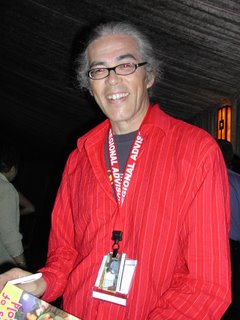
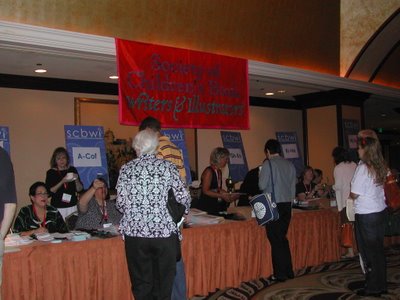
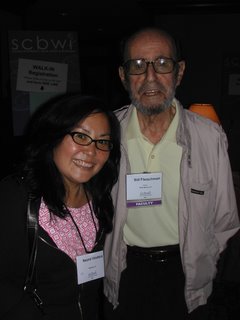
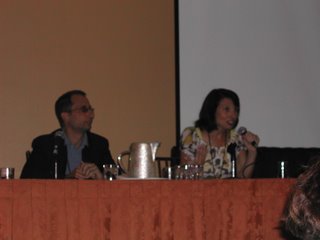
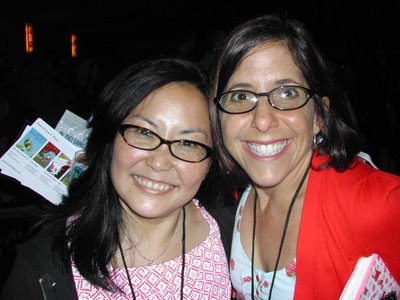
SCBWI? What's that? A new dance? A new IM term? No, it stands for the Society of Children Book Writers and Illustrators, a group which has its national conference in Century City (that's in Los Angeles) every August.
Like last year, I attended for just one day and this year my magic day was Friday, which opened the whole four-day event. I had grand plans to do an in-depth post, but I'm so dog-tired that I'm going to cheat with some photos.
There were 900 full-time registrants! Unbelievable. And at least 400 were published children's book authors. I've been to many writer events in my day, but let me tell you--the SCBWI national conference is one of the most organized. They even served everyone Dove bars before the last two sessions of the day. In other words, they had thought of everything.
The striking man in red up above in Christopher Cheng, an Australian author and animal enthusiast who's father is Chinese. I didn't know this but the Chinese assisted in the Australian gold rush, mirroring the experience of Chinese in California. There was an anti-Chinese movement in Australia, too (Chris showed us a slide of "roll out" banner declaring the explusion of Chinese from the area). He's written three books about the Chinese Australian experience and spoke about writing historical fiction for children. He also tossed out mini-stuffed koalas (they are not bears, everyone--marsupials!) and boomerang keychains to hold our attention. A smart former primary teacher!
Probably the most helpful session was "Getting Serious About Series: An Author & Her Editor Talk About How Series Evolve," featuring Margaret Peterson Haddix, author of the Shadow Children and Missing series, and editor, David Gale. A few observations for writers out there who may be contemplating writing a series for children:
For unpublished writers, don't pitch a whole series to a publisher or agent--unless perhaps it's for the paperback market. A publisher is reluctant to commit itself to a series written by an unproven talent. Why? It's a big monetary commitment, takes away a publishing slot for multiple seasons, etc. If you are interested in writing a paperback series, you have to write fast--perhaps 3 to 4 books a year.
Instead, pitch your first in the series as a standalone. If it does well, the publisher will go back to you for the series. Hardcover series are published once a year for multiple years.
Be flexible as you develop your series. You don't have to map out every book. Secondary characters may end up to be major characters in later books.
A writer's new series needs to be bigger than her future one. (In other words, the pressure's on.)
The whole 12 hours in Century City was amazing. I met legends in children's literature like Sid Fleischman (middle row, right). But perhaps the most "kairos" moment was when I was looking for a good place to eat my yogurt cheese and Europane-baked ciabatta sandwich and saw another bespectacled woman seated alone on the steps near the swimming pool. I asked whether I could with her and it turned out that she was, in fact, a writer at the same publishing house (Delacorte) with the same editor (Claudia Gabel)! And I had even read her book (Stray--get it, you'll love it). It was literally a one out of 1000 (well, 900) chance that I would run into Stacey Goldblatt--a wonderful meeting in a wonderful day. Labels: children's series fiction, Christopher Cheng, Margaret Peterson Haddix, SCBWI, Stacey Goldblatt |
posted by Naomi Hirahara @ 5:23 PM   |
|
|
|
| Thursday, July 24, 2008 |
| 1001 Crane Display (Kawaharas) |
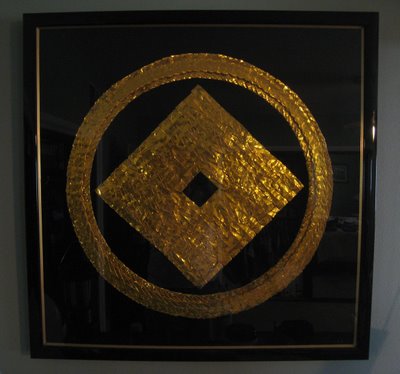
This is the 1001 crane display for my friend Martie and her husband Bobby (his full name is actually Robert). I actually folded some of the cranes, but I think that they may have been rejected by Bobby. The cranes are arranged in the shape of a mon, Japanese family crest, of Bobby's family. Labels: 1001 crane displays |
posted by Naomi Hirahara @ 6:40 PM   |
|
|
|
| Monday, July 21, 2008 |
| Fold Cranes for Japanese American Internment Memorial |
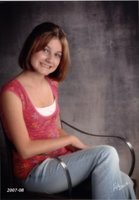 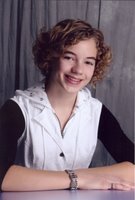 During the Fourth of July weekend, I had the pleasure of attending the Enduring Communities conference in Denver organized by the Japanese American National Museum. There I met Mary Reed, a Minnesota woman who is helping her daughter Michelle (right) and Michelle's friend Carly (left) in folding cranes for a Japanese American Internment Memorial. During the Fourth of July weekend, I had the pleasure of attending the Enduring Communities conference in Denver organized by the Japanese American National Museum. There I met Mary Reed, a Minnesota woman who is helping her daughter Michelle (right) and Michelle's friend Carly (left) in folding cranes for a Japanese American Internment Memorial.
Here's some information from their flyer:
Our names are Michelle Reed and Carly Gutzmann and we are fourteen years old.
There is a quote by Yehuda Bauer that is inscribed at the National Holocaust Memorial in Washington, D.C. that reads:
Thou shalt not be a victim.
Thou shalt not be perpetrator.
Above all, thou shalt not be a bystander.
We have never been victims and we have certainly never been perpetrators. Now is our chance to no longer be bystanders.
In 2006/2007, we worked together on a project for National History Day. We chose to make a documentary about the art school at Topaz Relocation Center. After eight months of researching Japanese American internment camps, we came to love the quiet strength and serenity of these people. We were sad to discover that most of our classmates and many adults had no idea about the internment camps in America during World War II!
We've chosen to make a memorial to the Japanese Americans who were interned during World War II. This project will take many months to complete, but our hope is that it will create an awareness of how we must create peace and tolerance in our world. This will only happen if, as individuals, we take the time to understand people who are different from us.
Our goal is to have one origami paper crane for each of the 120,313 Japanese Americans who were interned during World War II.
You can help us by making one or more paper cranes. Please make three-inch or smaller cranes. Also, send us your internment stories. You can mail them to us at:
Paper Cranes
c/o Silicon Graphics, Inc
2750 Blue Water Road
Eagan, MN 55121
We would like to thank Silicon Graphics for graciously allowing us to use their resources to receive the parcels and letters containing the paper cranes.
http://www.sgi.com/
For additional information about the Peace Memorial, e-mail:
cranes@flamingopond.org
Labels: internment, origami |
posted by Naomi Hirahara @ 3:52 PM   |
|
|
|
|
|

